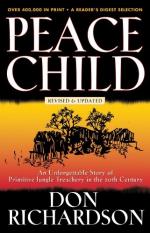|
This section contains 763 words (approx. 2 pages at 400 words per page) |

|
Peace Child Summary & Study Guide Description
Peace Child Summary & Study Guide includes comprehensive information and analysis to help you understand the book. This study guide contains the following sections:
This detailed literature summary also contains Topics for Discussion and a Free Quiz on Peace Child by Don Richardson.
This book opens up with the story of Yae, a native Sawi in Netherlands Guinea. He strikes up what he believes to be a peace treaty with a neighboring village. However, he finds that his new friends are only practicing the Sawi tradition of tuwi asonai man. In this practice, warriors persuade a man to become their friend, with the intention of killing and eating him later. The more complicated the plan, the more honorable the warrior becomes among his own village. Then, the men of the victim's village begin to plan their revenge. Such murders exist in a cycle of violence within the Sawi culture.
The arrival of strange outsiders rocks the world of the Sawi, however. Europeans and North Americans begin to survey the island for various reasons, from governmental rule to religious concern. A nearby tribe, the Kayagar, arrives on the banks of the Kronkel River to demonstrate the new tools acquired from the pale-skinned people they call the Tuans. The Sawi marvel over steel axes and razorblades.
Kani, a relative of a man killed in retribution for Yae's murder, realizes that he must plan his revenge before the Tuans arrive among the Sawi. He devises a plan of betraying the offending village through one of the enemy's mother-in-laws. Once the betrayal is complete, the story of Kani's treachery spreads through the Sawi culture, fast making him a Legendmaker around the Sawi campfires.
Meanwhile, in Canada, an old man who is a representative from a missionary agency, pleads for the young people in Bible College to consider ministering to the people of Netherlands Guinea. One couple, Don and Carol Richardson, answer the call. Within a few short years, the couple lands in the mountains of Netherlands New Guinea. They make new friends among other missionaries as they travel to the low, swampy area of the Sawi. At once, Richardson chooses a site to build his home and begins learning the previously undocumented language of the Sawi.
The Richardsons seek for some way to relate the news of the gospel to the Sawi. Richardson tells them stories of the bible, until he realizes with alarm that the Sawi see Judas as a hero for his friendship and then betrayal of Jesus. In addition, the tree villagers that come to live in the area surrounding the Tuans fail to live at peace. Richardson announces to the village leaders that, until peace comes to the area, he will leave for another Sawi village. Desperate to keep the Tuans and their supply of steel tools nearby, the Sawi perform an emotional peace child ceremony. Each village presents the enemy with an infant as a peace child. As long as the child lives, they explain to Richardson, the village lives at peace. In the case of an offense, someone may plead the peace child and strife will cease.
Richardson seizes upon the concept as a redemptive analogy for his religious doctrines. He calls Jesus Christ as the perfect peace child. He explains that any man who accepts God's peace child never needs to offer a human peace child again. The idea strikes a chord with the Sawi, but none of them accepts the news for themselves.
Then, Richardson returns to the village after traveling with his wife to the missionary outpost for the birth of their second son. On the way, their canoes capsize in the midst of crocodile-infested swamp water. They recover both children and, with the aid of a passing native, make way back to their jungle home. The Sawi threatens to beat the Richardson's native houseboy for the accident, but Richardson steps in to the boy's defense, crediting him with the rescue of the missionary's two sons. That day, several young Sawi men, including the Richardson's servant, personally accept the gospel of Jesus. Soon after, Hato, an elder in the village, also accepts Richardson's teachings.
The acceptance of Christianity changes the face of the Sawi village. The natives live in relative peace with their families and neighbors. Any time old offenses arise, someone will plead God's peace child and forgiveness follows. As the new spreads to all of the villages, Richardson begins construction of Sawidome, a large, thatched roof structure to house the meetings of the growing congregation. He also teaches the Sawi converts to read in their own language.
Richardson credits the conversions in Guinea with his discovery of the culture's preexisting redemptive analogies. He gives examples of redemptive analogies in other native cultures, as well. He rejoices in the peace Christianity brought to otherwise violent societies.
Read more from the Study Guide
|
This section contains 763 words (approx. 2 pages at 400 words per page) |

|



